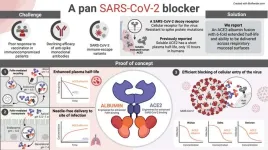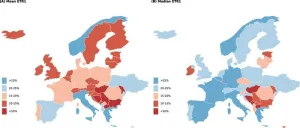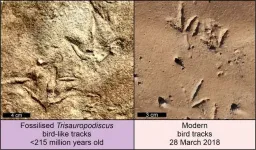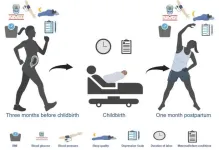(Press-News.org) EMBARGOED FOR RELEASE UNTIL 4 P.M. ET, WEDNESDAY, NOVEMBER 29, 2023
MINNEAPOLIS – A study of post-9/11 veterans shows that those with moderate or severe traumatic brain injury (TBI) who have never been deployed have a higher risk of epilepsy than those who have been deployed. The study is published in the November 29, 2023, online issue of Neurology®, the medical journal of the American Academy of Neurology.
“We anticipated that deployment would be linked to a higher risk of epilepsy among post-9/11 veterans with TBI given the potential higher risk for a blast or combat exposure,” said study author Mary Jo V. Pugh, PhD, RN, of VA Salt Lake City in Utah and a Fellow of the American Academy of Neurology. “However, we found that epilepsy was more common among those with moderate TBI who had never been deployed. This may be explained by the ‘healthy warrior effect,’ where good health is required for deployment. We found those who had not been deployed had higher percentages of epilepsy risk factors, including brain tumors, stroke, and other neurologic diseases.”
TBI is caused by a bump, blow or jolt to the head or by an injury to the head caused by falls, motor vehicle crashes or assaults. With moderate TBI a person loses consciousness for up to a day. Severe TBI involves losing consciousness for more than a day.
Pugh said the study also found that among those who had penetrating TBI, the most severe type of TBI, the risk of epilepsy was higher for deployed vets. Penetrating TBI can be caused by bullets, shrapnel, knives or other sharp objects.
The study involved 938,890 post-9/11 veterans with an average age of 35. Of the total participants, 71% had been deployed and 2.9% had epilepsy. Epilepsy was more common among veterans who were never deployed with 3.9% versus those who were deployed with 2.5%.
Researchers looked at medical records to determine which participants had TBI and what level of TBI. Overall, 14% of non-deployed veterans had TBI and 34% of deployed veterans had TBI.
When looking at TBI severity, researchers found that epilepsy risk for those with mild TBI did not differ by deployment status, but there were differences by deployment status for those with more severe TBI.
Researchers found that 1.2% of non-deployed veterans and 2.5% of deployed veterans had moderate or severe TBI. After adjusting for age, sex, and other risk factors for epilepsy, they found that among those with moderate and severe TBI, those who were not deployed were nearly three times more likely to have epilepsy and those who were deployed were two times more likely to have epilepsy when compared to those without TBI.
They also found 0.2% of non-deployed veterans and 0.5% of deployed veterans had penetrating TBI. Of the veterans who had penetrating TBI, those who were not deployed were four times more likely to have epilepsy and those who were deployed were more than five times more likely to have epilepsy when compared to those who did not have TBI.
“Closer monitoring for epilepsy among those with more risk factors for the disease may help shorten the time to diagnosis and appropriate treatment,” Pugh added.
A limitation of the study is that results may not be generalizable to other veteran groups, such as older veterans, due to their differing war exposures.
The study was supported by the Department of Defense.
Learn more about traumatic brain injury at BrainandLife.org, home of the American Academy of Neurology’s free patient and caregiver magazine focused on the intersection of neurologic disease and brain health. Follow Brain & Life® on Facebook, Twitter and Instagram.
When posting to social media channels about this research, we encourage you to use the hashtags #Neurology and #AANscience.
The American Academy of Neurology is the world’s largest association of neurologists and neuroscience professionals, with over 40,000 members. The AAN is dedicated to promoting the highest quality patient-centered neurologic care. A neurologist is a doctor with specialized training in diagnosing, treating and managing disorders of the brain and nervous system such as Alzheimer’s disease, stroke, migraine, multiple sclerosis, concussion, Parkinson’s disease and epilepsy.
For more information about the American Academy of Neurology, visit AAN.com or find us on Facebook, Twitter, Instagram, LinkedIn and YouTube.
END
With some forms of TBI, non-deployed vets have higher risk of epilepsy than deployed
2023-11-29
ELSE PRESS RELEASES FROM THIS DATE:
Certain migraine medications may be more effective than Ibuprofen
2023-11-29
EMBARGOED FOR RELEASE UNTIL 4 P.M. ET, WEDNESDAY, NOVEMBER 29, 2023
MINNEAPOLIS – For many people with migraine, it can be difficult to find a treatment that is effective and reliable, and information on how medications compare to one another is lacking. A new study draws data from nearly 300,000 people using a smartphone app to help people make decisions about their medications. The study found that certain migraine medications like triptans, ergots and anti-emetics may be two to five times more effective than ibuprofen ...
Embedding fibers to undo the tapestry of memory loss in Alzheimer's disease
2023-11-29
Every 65 seconds, someone in the United States develops Alzheimer’s disease, a devastating form of dementia that affects 6.2 million Americans.
Though it was initially identified almost 120 years ago, Alzheimer’s disease is a progressive neurological disorder with no cure and few treatments. It starts out with minor memory loss that, over time, advances to a mental decline so severe, individuals have difficulty even swallowing.
Xiaoting Jia, associate professor in the Bradley Department of Electrical ...
Novel study finds aspirin-free regimen benefits patients with LVAD
2023-11-29
The ARIES-HM3 Randomized Clinical Trial assessed the safety and efficacy of excluding aspirin from the antithrombotic regimen in patients with advanced heart failure who have undergone implantation of a fully magnetically levitated left ventricular assist device (LVAD).
“We can now safely say that not giving aspirin is not only safe from a thromboembolic risk profile but results in improved adverse event rate by a significant reduction in non-surgical bleeding which is a well-known complication related to LVAD therapy,” said Mirnela Byku, M.D., Ph.D., MBA, co-author of the study and director of the UNC Durable Mechanical ...
Your local sea snail might not make it in warmer oceans – but oysters will
2023-11-29
The frilled dog winkle may sound like a complex knot for a tie, but this local sea snail holds clues to our warmer future, including a dire outlook for species that can’t move, adapt, or acclimate as fast as their environment heats up.
Strait of Georgia hotspot
To figure out how location affects vulnerability to a changing climate, UBC zoology researchers Drs. Fiona Beaty and Chris Harley collected marine snails from the Strait of Georgia, a potential hot spot of climate risk, and the Central Coast, where waters are cooler and warming more slowly.
They monitored snails ...
600 years of tree rings reveal climate risks in California
2023-11-29
The San Joaquin Valley in California has experienced vast variability in climate extremes, with droughts and floods that were more severe and lasted longer than what has been seen in the modern record, according to a new study of 600 years of tree rings from the valley.
The researchers used the tree rings to reconstruct plausible daily records of weather and streamflow scenarios during the 600-year period.
This new approach, combining paleo information with synthetic weather generation, may help policymakers and scientists better understand – and anticipate ...
Big cities foster socioeconomic segregation; Here’s how we can fix that
2023-11-29
We tend to think of large cities as melting pots – places where people from all sorts of backgrounds can mingle and interact. But according to new research, people in big cities tend to primarily interact with other individuals in the same socioeconomic bracket, whereas people in small cities and rural areas are much more likely to have diverse interactions.
Using cellphone data, a collaboration of researchers led by Stanford University determined that most people in big cities have very few opportunities for even brief interactions with those outside their own socioeconomic status. ...
A long-acting biologic with transmucosal transport properties that arrest SARS-CoV-2 virus variants
2023-11-29
When the COVID-19 pandemic first started, no effective anti-viral drugs were available to fight the disease. However, in record time, so-called monoclonal antibodies were developed as a lifesaving treatment. Now, 3 years later, none of the approved antibodies work effectively against the new SARS-CoV-2 virus variants due to mutations that alter their spike protein.
While vaccines protect against severe disease, there is still an urgent need for effective virus-blocking agents for therapeutic or prophylactic use. This is particularly relevant for patients ...
Study reveals the real tax rate paid by multinational corporations in 47 countries
2023-11-29
Despite a similar statutory tax rate for multinational corporations (MNCs) across many countries, the effective tax rate that MNCs actually pay differs greatly — as low as 1% of gross income in Luxembourg and as high as 67% in Norway. That’s one conclusion of a study published this week in the open-access journal PLOS ONE by Javier Garcia-Bernardo of Utrecht University, the Netherlands, Petr Janský of Charles University, Czechia, and Thomas Tørsløv of Danmarks Nationalbank, Denmark. The study comes on the ...
Unknown animals were leaving bird-like footprints in Late Triassic Southern Africa
2023-11-29
Ancient animals were walking around on bird-like feet over 210 million years ago, according to a study published November 29, 2023 in the open-access journal PLOS ONE by Miengah Abrahams and Emese M. Bordy of the University of Cape Town, South Africa.
Numerous fossil sites in southern Africa preserve distinctive three-toed footprints that have been named Trisauropodiscus. For many years, researchers have debated what animals might have left these tracks, as well as precisely how many different species (technically called ichnospecies) of Trisauropodiscus there are.
In this study, the researchers reassessed the ...
Exercise may reduce postpartum depression, with moderate intensity exercises three to four times a week being especially effective, per meta-analysis
2023-11-29
Exercise may reduce postpartum depression, with moderate intensity exercises three to four times a week being especially effective, per meta-analysis
###
Article URL: https://journals.plos.org/plosone/article?id=10.1371/journal.pone.0287650
Article Title: Effectiveness of aerobic exercise in the prevention and treatment of postpartum depression: Meta-analysis and network meta-analysis
Author Countries: China
Funding: This work was financially supported by the Fundamental Research Funds for the Central Universities in China (Grant no. CUG150607). The funders did not play a role ...





